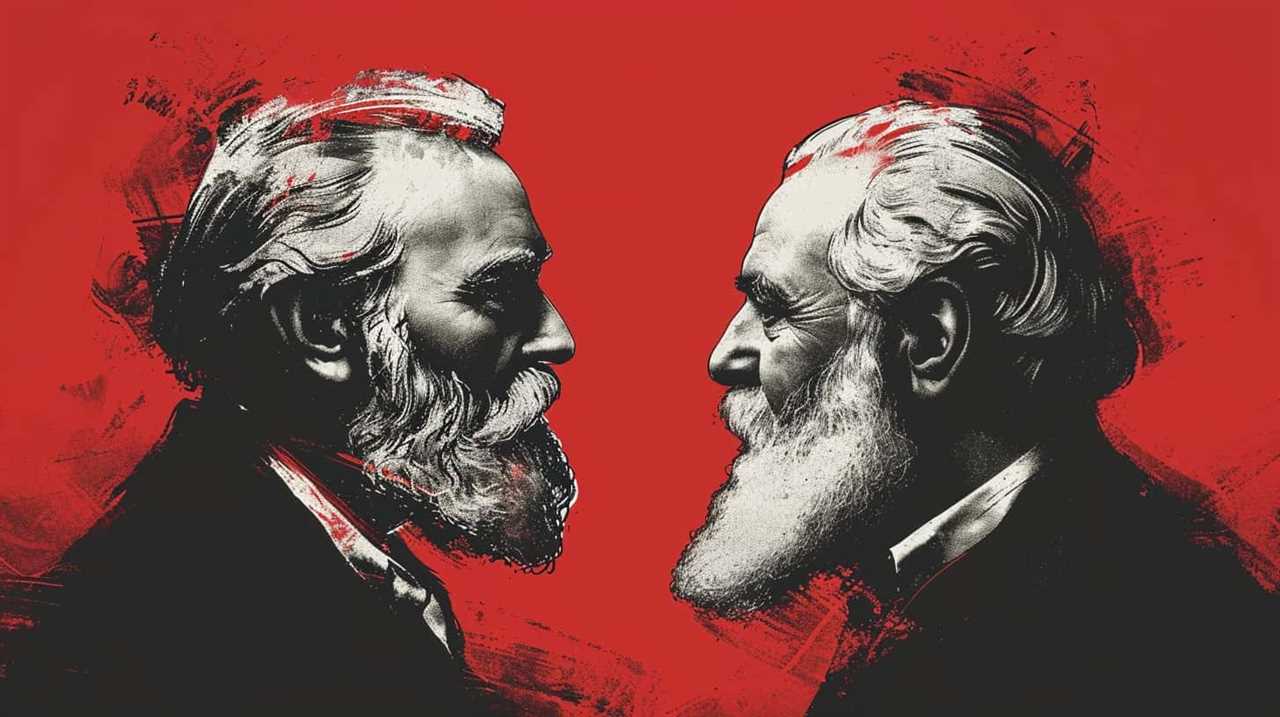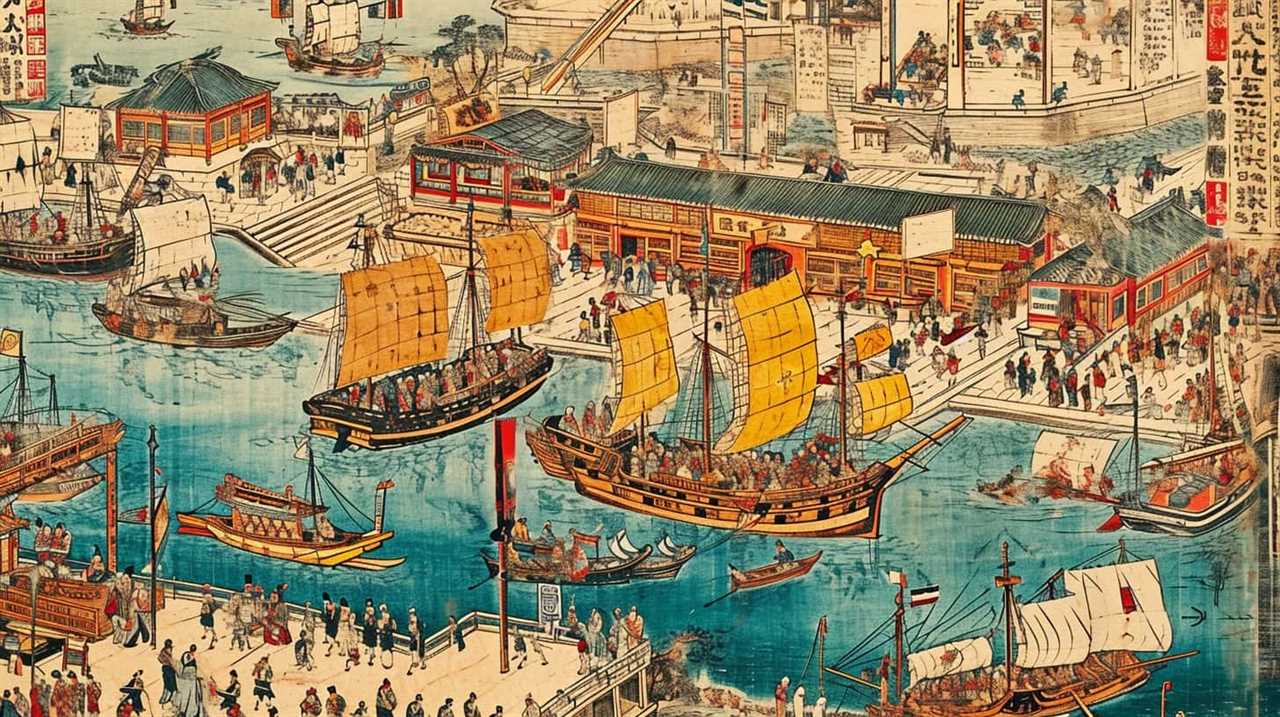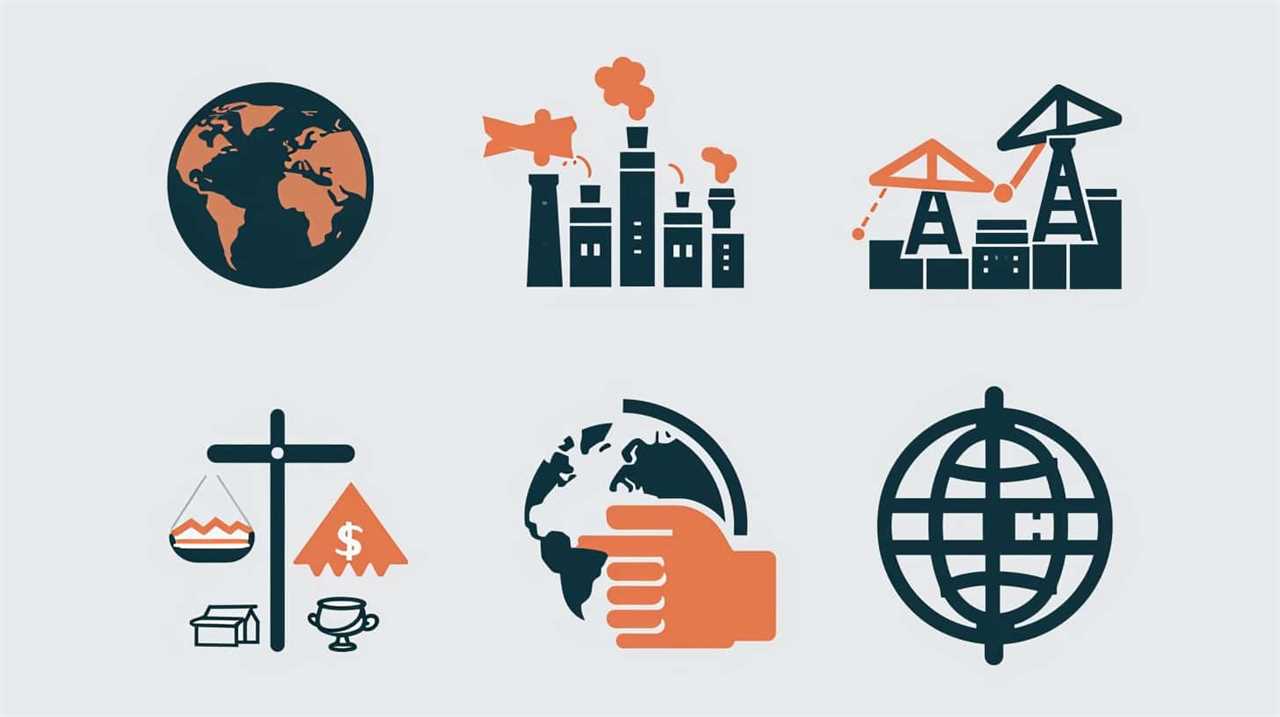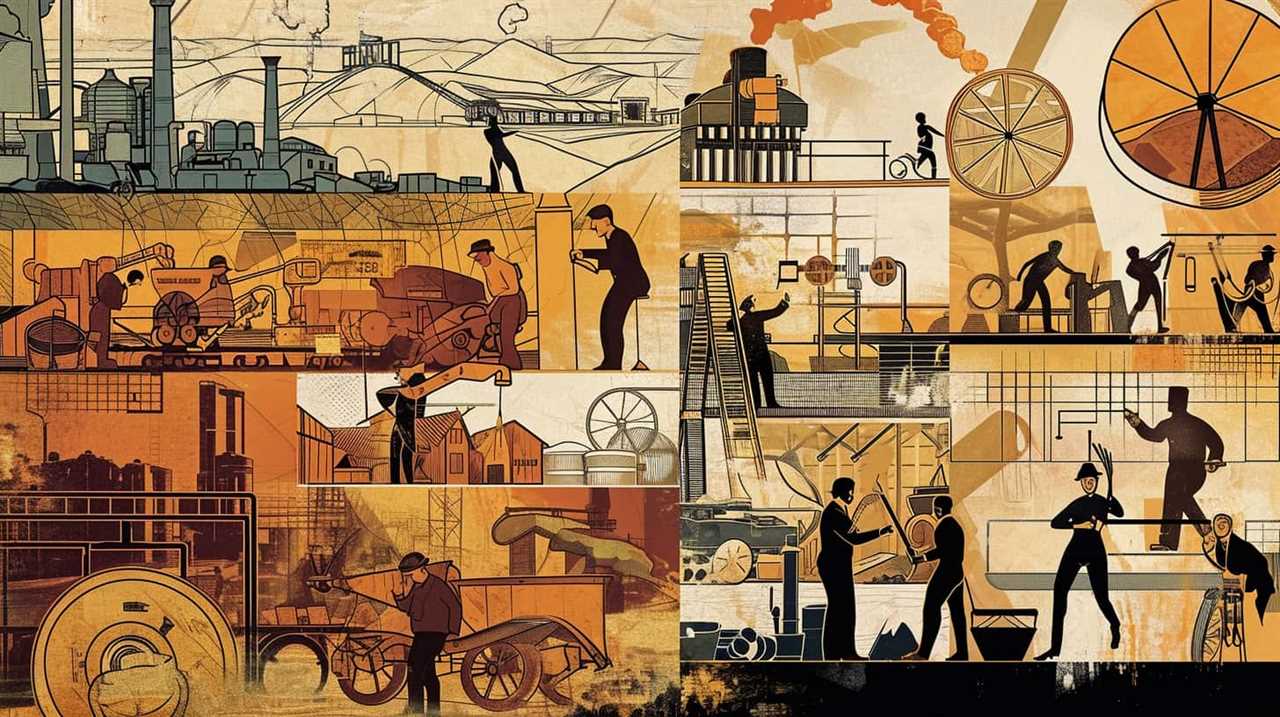Are you prepared to delve into the brilliant mind of Milton Friedman and explore his free market wisdom? Come along as we navigate through the complex world of economic theories and policy proposals that have transformed our understanding of innovation and progress.
In this concise guide, we will delve into topics such as the role of government in free markets, deregulation and economic growth, and the social responsibility of business. Prepare to challenge your existing beliefs and open your mind to new possibilities as we uncover the groundbreaking ideas of one of the most influential economists of our time.
Let’s dive in and discover the keys to navigating Milton Friedman’s free market wisdom.
Key Takeaways
- Milton Friedman’s belief in individual freedom and limited government intervention shaped his advocacy for minimal government intervention in the economy.
- Friedman emphasized the necessary role of government in protecting property rights, enforcing contracts, regulating externalities, and ensuring fair competition.
- Deregulation was seen by Friedman as a means to increase innovation, competition, and productivity, but it should be balanced with necessary regulations for sustainable and inclusive economic development.
- When considering the impact of deregulation, it is important to balance the potential benefits on employment and market competition with the need to protect public health and safety, ensure fair competition, and promote environmental sustainability.
Early Influences and Education
In our exploration of Milton Friedman’s free market wisdom, we begin by examining the early influences and education that shaped his economic views.

Growing up in a family that valued intellectual pursuits, Friedman was exposed to economic discussions from an early age. His parents’ belief in individual freedom and limited government intervention served as a foundation for his later advocacy of free markets. Additionally, his experiences during the Great Depression, witnessing the devastating consequences of government policies, further cemented his commitment to free market principles.
Friedman’s education played a crucial role in shaping his economic views. He attended Rutgers University, where he studied economics and developed a deep understanding of classical economic theories. Later, he pursued graduate studies at the University of Chicago, where he was exposed to the influential ideas of economists like Frank Knight and Jacob Viner.
During his time at the University of Chicago, Friedman was also influenced by the teachings of Friedrich Hayek, who emphasized the importance of individual liberty and the dangers of government intervention. These early influences, combined with his rigorous academic training, laid the groundwork for Friedman’s later contributions to economic theory and policy.
The Role of Government in Free Markets
Our understanding of Milton Friedman’s free market wisdom is incomplete without examining the crucial role that government plays in free markets. While Friedman advocated for minimal government intervention in the economy, he acknowledged the necessity of certain government functions to ensure the smooth operation of free markets. In this section, we will explore the role of government in free markets and the extent to which market intervention is required.

To better understand the role of government in free markets, let us examine the table below:
| Government Role | Examples of Market Intervention |
|---|---|
| Protection of property rights | Enforcing contracts, intellectual property laws |
| Regulation of externalities | Imposing taxes on pollution, setting emission standards |
| Provision of public goods and services | Building infrastructure, funding education and healthcare |
| Ensuring fair competition | Enforcing antitrust laws, preventing monopolies and price fixing |
| Correcting market failures | Implementing social safety nets, addressing information asymmetry |
As the table illustrates, government intervention in free markets is necessary to protect property rights, address externalities, provide public goods, ensure competition, and correct market failures. However, it is important to strike a balance, as excessive intervention can hinder innovation and economic growth.
In the subsequent section, we will delve into the topic of deregulation and its impact on economic growth.
Deregulation and Economic Growth
Deregulation has long been touted as a catalyst for economic growth. By removing burdensome regulations, businesses are able to operate more freely and efficiently, leading to increased innovation, competition, and productivity.

However, it’s important to consider the impact of deregulation on various sectors and stakeholders. While deregulation may benefit some businesses by reducing costs and promoting investment, it can also have negative consequences for consumers, workers, and the environment. For example, deregulation in the financial sector has been blamed for contributing to the global financial crisis of 2008.
Therefore, it is necessary to strike a balance between regulation and growth to ensure sustainable and inclusive economic development. Regulation plays a crucial role in protecting public health and safety, promoting fair competition, and safeguarding the environment. At the same time, excessive regulation can stifle innovation and hinder entrepreneurial activity.
Deregulation Spurs Economic Growth
We believe that embracing deregulation is essential for fostering economic growth. Deregulation refers to the reduction or elimination of government intervention in the market.
By reducing unnecessary regulations and barriers, we create a more competitive playing field that encourages innovation and efficiency.

Here are four key reasons why deregulation spurs economic growth:
- Increased market competition: Deregulation allows for more players to enter the market, fostering healthy competition and driving businesses to innovate and improve their products and services.
- Lower costs for businesses: Reduced regulations mean fewer compliance costs, enabling businesses to allocate resources towards growth and expansion.
- Encouragement of entrepreneurship: Deregulation provides opportunities for new entrepreneurs to enter the market and bring fresh ideas and solutions.
- Enhanced consumer choice: Deregulation leads to a wider range of products and services, giving consumers more options and the ability to make choices that best suit their needs.
Impact of Deregulation
Through the implementation of deregulation, the economy experiences a transformative impact on growth and development. Deregulation has a significant influence on employment, as it allows for increased competition in the market.
When regulations are reduced or eliminated, businesses have more flexibility to hire and expand, leading to job creation and reduced unemployment rates. Deregulation also fosters market competition, which encourages businesses to innovate and improve their products and services. This competition results in higher productivity and efficiency, leading to economic growth.
Balancing Regulation and Growth
To achieve a balance between regulation and growth, it’s crucial to carefully consider the impact of deregulation on economic growth. Deregulation, when done strategically, can promote market competition and spur innovation, leading to increased productivity and economic expansion. However, it’s important to recognize that certain sectors may require government intervention to prevent market failures and protect the interests of consumers.

Finding the right balance between regulation and deregulation is essential for fostering a thriving economy.
- Deregulation can encourage market competition, driving businesses to innovate and improve efficiency.
- Excessive regulation can stifle entrepreneurship and hinder economic growth.
- Careful evaluation of industry-specific regulations is necessary to identify areas where deregulation can be beneficial.
- Government intervention may be needed to address externalities, ensure fair competition, and protect consumers’ rights.
Inflation and Monetary Policy
In the realm of economic policy, understanding the impact of inflation and the role of monetary policy is crucial. Inflation management is a key concern for policymakers, as it can have significant implications for the economy. Central bank policies play a crucial role in managing inflation and ensuring price stability.
Central banks have various tools at their disposal to manage inflation. One such tool is monetary policy, which involves controlling the money supply and interest rates. By adjusting interest rates, central banks can influence borrowing costs and consumer spending, which in turn can affect inflation. Additionally, central banks can use open market operations to buy or sell government securities, thereby influencing the money supply.
The goal of central bank policies is to maintain price stability, which means keeping inflation at a low and stable level. This is important as high inflation erodes the purchasing power of money and can lead to economic instability. Central banks typically have an inflation target, which guides their monetary policy decisions.

In recent years, central banks have faced challenges in managing inflation due to changing economic conditions. Factors such as globalization, technological advancements, and demographic shifts have made it more difficult to accurately measure and predict inflation. As a result, central banks have had to adapt their monetary policy frameworks to better address these challenges.
The Negative Income Tax Proposal
We frequently encounter Milton Friedman’s free market wisdom, and one notable proposal is the Negative Income Tax. This proposal, introduced by Friedman in his book ‘Capitalism and Freedom,’ suggests a drastic reform to the welfare system by replacing it with a negative income tax. This tax would provide a guaranteed minimum income for all citizens, effectively reducing poverty and promoting individual freedom.
The negative income tax would incentivize work by ensuring that individuals always have an incentive to earn more income, as any additional income earned would only result in a partial reduction in the subsidy received.
It would simplify the welfare system by eliminating the need for multiple welfare programs and reducing bureaucracy, leading to cost savings and increased efficiency.

The negative income tax would empower individuals by giving them the freedom to choose how to spend their subsidy, allowing them to make decisions that align with their unique circumstances and priorities.
By targeting poverty reduction directly, the negative income tax would address the root causes of poverty and provide a more effective and efficient approach to welfare reform.
Transitioning into the subsequent section about free trade and globalization, implementing the negative income tax could also have implications for these areas.
Free Trade and Globalization
As we delve into Milton Friedman’s free market wisdom, it is important to examine the impact of free trade and globalization. These concepts have revolutionized the way economies operate, leading to the creation of global supply chains and increased interconnectivity among nations. Free trade allows countries to specialize in producing goods and services that they have a comparative advantage in, leading to increased efficiency and productivity. This, in turn, fosters innovation and economic growth.

However, the rise of protectionism poses a challenge to the benefits of free trade. Protectionist policies, such as tariffs and quotas, aim to shield domestic industries from foreign competition. While they may offer short-term protection for certain industries, they often lead to higher prices for consumers and hinder the overall efficiency of the global market.
To further illustrate the impact of free trade and globalization, let’s take a look at the following table:
| Pros of Free Trade and Globalization | Cons of Protectionism |
|---|---|
| Promotes economic growth and innovation | Increases consumer prices |
| Expands global supply chains | Hinders global market efficiency |
| Enhances specialization and productivity | May lead to trade disputes |
| Fosters international cooperation | Limits choice and variety for consumers |
Privatization and Public Services
When it comes to discussing privatization and public services, it’s important to consider the inefficiencies that can arise in public service delivery. By introducing competition through privatization, there’s potential for increased efficiency and cost-effectiveness in the provision of public services.
However, it’s crucial to also analyze the potential economic impact of privatization, as it can lead to job losses and reduced accessibility for certain segments of the population.

Public Service Inefficiencies
Public service inefficiencies can be addressed through privatization and improving the delivery of public services. By reducing government bureaucracy and implementing cost-cutting measures, public services can become more efficient and effective.
To emphasize the importance of addressing public service inefficiencies, consider the following:
- Enhanced accountability: Privatization introduces competition, forcing service providers to be more accountable for their performance.
- Increased innovation: Private companies often have more flexibility to innovate and find creative solutions to deliver public services.
- Streamlined processes: By implementing cost-cutting measures, unnecessary bureaucracy can be eliminated, leading to streamlined processes and faster service delivery.
- Improved customer satisfaction: Private companies are often more focused on customer satisfaction, leading to better service quality and responsiveness.
Addressing public service inefficiencies through privatization and improving service delivery can lead to more innovative and efficient public services, ultimately benefiting the public.
Economic Impact of Privatization
To understand the economic impact of privatization on public services, we must analyze the advantages and potential drawbacks of implementing free market principles.

Privatization, which involves transferring ownership and control of public services from the government to private entities, is often touted for its potential to improve economic efficiency. Proponents argue that competition in the private sector can drive innovation, reduce costs, and improve the quality of services. This shift away from government intervention can lead to increased productivity and effectiveness in delivering public services.
However, critics of privatization caution that it may result in the loss of accountability and accessibility, particularly for vulnerable populations who rely heavily on public services. They argue that the profit motive of private companies may prioritize financial gain over meeting the needs of the public.
Striking a balance between the benefits of privatization and the need for government intervention is crucial in ensuring that public services remain efficient and accessible to all.
Education and School Choice
Our experience with education and school choice has led us to reevaluate the effectiveness of traditional public schools. While these institutions have been the cornerstone of education in our society, we believe that exploring alternative options can lead to greater innovation and individualized learning experiences.

Here are some key points to consider:
- School Vouchers: The implementation of school vouchers allows parents to use public funds to send their children to private or charter schools. This empowers parents to choose a school that aligns with their child’s unique needs and preferences.
- Homeschooling Options: Homeschooling provides an alternative to traditional classroom settings, allowing parents to take direct control over their child’s education. This approach fosters a personalized learning experience and encourages independent thinking.
- Increased Competition: School choice initiatives promote healthy competition among educational institutions. This encourages schools to strive for excellence and continually improve their teaching methods and curriculum.
- Innovation in Education: By embracing school choice, we create an environment that encourages experimentation and innovation in educational practices. This can lead to the development of new teaching methods and technologies that better engage students and enhance their learning outcomes.
As we explore the potential of education and school choice, it’s important to consider the social responsibility of businesses in shaping the future of education.
The Social Responsibility of Business
When considering the social responsibility of business, it’s important to examine the relationship between business and society.
One key aspect is the ethical obligations of corporations, as they have the power and influence to shape communities and impact individuals.

This raises the question of whether businesses should prioritize profit or also consider their social impact, and finding the right balance is crucial in promoting a thriving economy and a just society.
Business and Society
In our modern society, businesses have a significant social responsibility to ensure the well-being and progress of the community they operate in. In order to fulfill this responsibility, businesses must adhere to strong business ethics and embrace corporate social responsibility.
Here are four key points to consider:
- Businesses should prioritize ethical decision-making, considering the impact of their actions on society and the environment.
- They should actively engage with stakeholders, seeking input and addressing concerns to foster trust and collaboration.
- Businesses should invest in sustainable practices, aiming to minimize their environmental footprint and promote long-term sustainability.
- They should also contribute to the community through philanthropy and social initiatives, supporting local causes and addressing social challenges.
By embracing these principles, businesses can effectively navigate their social responsibility and contribute to the betterment of society.

Now, let’s delve into the ethical obligations of corporations.
Ethical Obligations of Corporations
As businesses navigate their social responsibility, they must recognize the ethical obligations they have as corporate entities. Corporate accountability and stakeholder management play a crucial role in fulfilling these obligations.
| Ethical Obligations | Importance |
|---|---|
| Transparency | Ensures trust and fosters long-term relationships with stakeholders |
| Fairness | Treats all stakeholders equitably and promotes a just business environment |
| Environmental Responsibility | Helps protect the planet and ensures sustainable practices |
Corporate accountability involves being answerable for the impact of business decisions on various stakeholders, including employees, customers, communities, and the environment. It requires businesses to act ethically, adhere to regulations, and be transparent in their operations. Stakeholder management, on the other hand, involves identifying, understanding, and addressing the needs and concerns of stakeholders. By actively engaging with stakeholders and considering their interests, businesses can build mutually beneficial relationships and contribute to the overall well-being of society. Embracing these ethical obligations is not only the right thing to do, but it also leads to long-term success and innovation.
Our ethical obligations as businesses include balancing profit and social impact to fulfill our social responsibility. In the realm of ethical capitalism, corporate social responsibility plays a crucial role in ensuring that businesses not only focus on maximizing profits but also consider their impact on society. It’s essential to strike a balance between making money and making a positive difference.

Here are four key points to consider:
- Investing in sustainable practices: By adopting environmentally friendly practices, businesses can reduce their carbon footprint and contribute to a greener future.
- Supporting local communities: Engaging with and investing in local communities can help businesses create a positive social impact by promoting economic growth and social well-being.
- Ethical sourcing and supply chain: Ensuring fair labor practices and responsible sourcing can help businesses support human rights and avoid contributing to unethical practices.
- Philanthropic initiatives: Engaging in philanthropy and supporting charitable causes can demonstrate a commitment to social responsibility and make a meaningful difference in society.
Criticisms and Controversies
While some critics and controversies surround Milton Friedman’s free market philosophy, it’s important to examine both the strengths and weaknesses of his ideas.
One criticism of Friedman’s free market philosophy is that it prioritizes economic efficiency over social welfare. Critics argue that this approach can lead to income inequality and the neglect of vulnerable populations. They argue that the market alone can’t address issues such as poverty, healthcare, and education, and that government intervention is necessary.
Another controversy surrounding Friedman’s ideas is his belief in limited government regulation. Critics argue that this can lead to market failures and unethical business practices, as seen in the 2008 financial crisis. They argue that regulations are necessary to protect consumers and ensure fair competition.

Despite these criticisms and controversies, Friedman’s free market philosophy has also garnered support. Proponents argue that it promotes individual freedom, innovation, and economic growth. They believe that the market, when left to its own devices, can efficiently allocate resources and create prosperity.
Legacy and Impact
Friedman’s free market philosophy continues to shape economic policies and spark debates on its lasting legacy and impact. His ideas have had a profound and long-term influence on the field of economics and continue to be discussed and analyzed by scholars, policymakers, and economists worldwide.
Legacy Assessment:
- Friedman’s advocacy for limited government intervention in the economy has been influential in shaping neoliberal economic policies. His ideas have played a significant role in the deregulation of industries and the reduction of government control.
- His emphasis on individual freedom and personal responsibility has had a lasting impact on the way society views the role of government in economic affairs. It has led to a shift towards more market-oriented policies and a greater emphasis on individual choice and competition.
- Friedman’s work on monetary policy and the role of the Federal Reserve has also left a lasting legacy. His ideas on controlling inflation through monetary policy have been influential in shaping central bank practices and policies around the world.
- His writings and teachings have inspired a new generation of economists, who continue to explore and expand upon his ideas, further contributing to his legacy.
Frequently Asked Questions
What Are Some Examples of Countries That Have Successfully Implemented Milton Friedman’s Free Market Principles?
Examples of countries successfully implementing Milton Friedman’s free market principles include Singapore, Hong Kong, and Chile. These nations have experienced benefits such as economic growth, increased entrepreneurship, and improved living standards due to the successful implementation of free market principles.

How Did Milton Friedman’s Views on the Role of Government in Free Markets Differ From Other Economists of His Time?
Milton Friedman’s views on the role of government in free markets differed from other economists of his time. He emphasized limited government intervention and believed in the power of free markets to drive economic growth and prosperity.
What Were Some of the Key Arguments Made by Critics of Milton Friedman’s Negative Income Tax Proposal?
Key criticisms of Friedman’s negative income tax proposal include concerns about its potential to disincentivize work and create dependency. Potential alternatives include targeted welfare programs and a focus on promoting economic growth and job creation.
Did Milton Friedman Believe That Free Trade and Globalization Were Always Beneficial for All Countries Involved?
Free trade and globalization, as believed by Milton Friedman, can have varied impacts on different countries. While they can promote economic growth, there are also criticisms regarding their impact on developing nations and income inequality.
How Did Milton Friedman’s Ideas on Privatization and Public Services Influence Government Policies in Different Countries?
Milton Friedman’s ideas on privatization and public services have had a significant influence on government policies in various countries. His emphasis on free markets and limited government intervention has led to the privatization of industries and a reduction in the scope of public services.

What Are the Key Similarities Between Milton Friedman’s Free Market Wisdom and Hayek’s Price Theory?
Milton Friedman’s free market wisdom and Hayek’s price theory shapes the belief in the efficient allocation of resources, the importance of individual choice, and the limitations of centralized planning. Both ideologies emphasize the role of prices in signaling information and coordinating economic activity within a market.
Conclusion
In conclusion, exploring Milton Friedman’s free market wisdom has been like embarking on a journey through a vast ocean of economic ideas.
Like a skilled navigator, Friedman guided us through the intricacies of government intervention, deregulation, inflation, and social responsibility.
With his powerful insights, he charted a course towards economic growth and individual freedom.
Though met with controversies and criticisms, Friedman’s legacy as a champion of free markets continues to shape our understanding of economics, leaving an indelible mark on the world.

Lauren’s talent in writing is matched by her passion for storytelling. Her love for books and deep understanding of culture and entertainment add a distinct flavor to her work. As our media and press contact, Lauren skillfully bridges the gap between afterQuotes and the broader media landscape, bringing our message to a wider audience.










